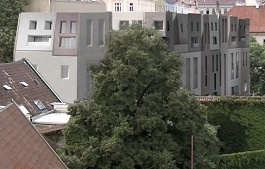
The Heritage Inspection has initiated a review process due to the 'marshmallow'
 |
It was this association that submitted the proposal to initiate the review proceedings. Its members, along with the Civil Monitoring Association, have long criticized the new construction, which people have nicknamed "marshmallow" due to the color of the facade shown in its visualization. The heritage inspection can amend or possibly annul the already issued mandatory opinions of the City Hall.
"The relevant mandatory opinion allowing the construction of the residential building according to the proposed architectural design also does not correspond with the Convention for the Protection of Architectural Heritage in Europe. By adopting it, the Czech Republic has committed to 'prevent the distortion, decay, or demolition of protected properties,'" the heritage inspection further stated.
The majority of the land on which the construction is planned belongs to Prague. The investor cannot start building yet. Besides the ongoing appeal period, the zoning decision for this construction will be reviewed based on the decision of the city construction office.
The project has sparked protests from hundreds of people in recent months. The house was designed by architect Zdeněk Fránek, and the project has changed several times. Regarding the extended visualizations, by which people nicknamed the house, he stated that he never counted on a facade in pink color.
The original version of the project from 2008 was rejected by the Ministry of Culture based on the opinion of the National Heritage Institute (NPÚ) and the permit from Prague heritage protectors was revoked in 2010. However, the new project by Praga Progetti e investimenti was approved by both NPÚ and city heritage protectors, based on which a building permit was issued, albeit still not final.
The English translation is powered by AI tool. Switch to Czech to view the original text source.
0 comments
add comment
Related articles
0
16.03.2016 | Investor of marshmallow is suing the Ministry of Culture
0
29.12.2015 | The marshmallow investor has a zoning decision, not the approval of heritage conservationists
0
25.11.2015 | The Ministry of Culture revoked the preservationists' permit for the marshmallow
0
23.09.2015 | Investor appealed against the cancellation of the decision for "marshmallow"
0
16.09.2015 | The magistrate canceled the issued land decision for "marshmallow"
0
26.08.2015 | The ministry has halted the review, the decision on the marshmallow stands
0
19.08.2015 | Six appeals have been filed against the authorization of Marshmallow
0
19.07.2015 | Marshmallow will also be addressed by the Ministry for Regional Development
0
30.06.2015 | The magistrate reviews the zoning decision for "Marshmallow"
0
22.06.2015 | The Heritage Association requests a review of the permit for marshmallow
0
17.06.2015 | The building called marshmallow has received a building permit from Prague 1
0
29.05.2015 | The association submitted a proposal to the magistrate regarding "Marshmallow"
0
21.05.2015 | The association is complaining to the Ministry of Culture's inspection about "Marshmallow"
18
13.05.2015 | Architekt: I never planned the house "Marshmallow" to be white-pink
0
01.05.2015 | In mid-May, there will be a discussion in Prague about the criticized marshmallow
0
22.04.2015 | There is no reason to appeal because of the "marshmallow," the leadership of Prague 1 has announced
0
15.04.2015 | Hundreds of people demonstrated against the construction near the Benedictine Monastery












